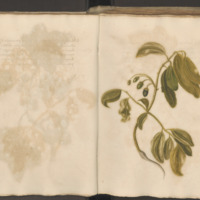Cinnamon
Dublin Core
Title
Subject
Cinnamon is a commonly known light brown spice made from the inner bark of a number of species of cinnamon trees, of the genus Cinnamomum. It has a delicate aroma and a sweet flavor.
Cinnamon oil comes in two forms: bark oil and leaf oil. Bark oil is often used for culinary purposes, whereas leaf oil is used as an essential oil because it has a high eugenol content with a clove-like aroma.
Description
Source
Fol. 1v - "For loosening the belly"
Prunes of Saint Antonin, & if you like you want put among them leaves of mallow & gilliflower, adding in sugar &, if one wants, a little cinnamon for the stomach.
Or else marshmallow root in a chicken broth. The fresh kind is more mollifying.
Beating syrup of sweet jujubes with water & taking it in the morning loosens the belly.
Fol. 47r - "For teeth"
Sal ammoniac i ℥, rock salt 1 ℥, alum half an ℥. Make water with the retort, and as soon as you touch the tooth, the tartar & blackness will go away. It is true that it has a bad odor, but you can mix it with rose honey & a little cinnamon or clove oil.
Fol. 48r - "Excellent mustard"
Dry bread in an oven, then lard it with cloves & cinnamon & thus put it to soak in good wine. Then, pass everything through a tammy cloth, being well pestled, & incorporate it with your mustard seed.
Contributor
“Cinnamon.” World Encyclopedia. Philips, 2014. https://www.oxfordreference.com/view/10.1093/acref/9780199546091.001.0001/acref-9780199546091-e-2461?rskey=LJSd9D&result=2.
Alan Davidson. “Cinnamon.” In The Oxford Companion to Food (2 ed.), edited by Jaine, Tom. Oxford University Press, 2013. https://www.oxfordreference.com/view/10.1093/acref/9780199546091.001.0001/acref-9780199546091-e-2461?rskey=LJSd9D&result=2.
Image: “Cinnamomum verum J.Presl.” fo32xiv-033r, Plantarum Malabaricarum icones BPL 126 D - part 1, Leiden University Libraries, http://hdl.handle.net/1887.1/item:937812.
Elia Zhang, Columbia University
